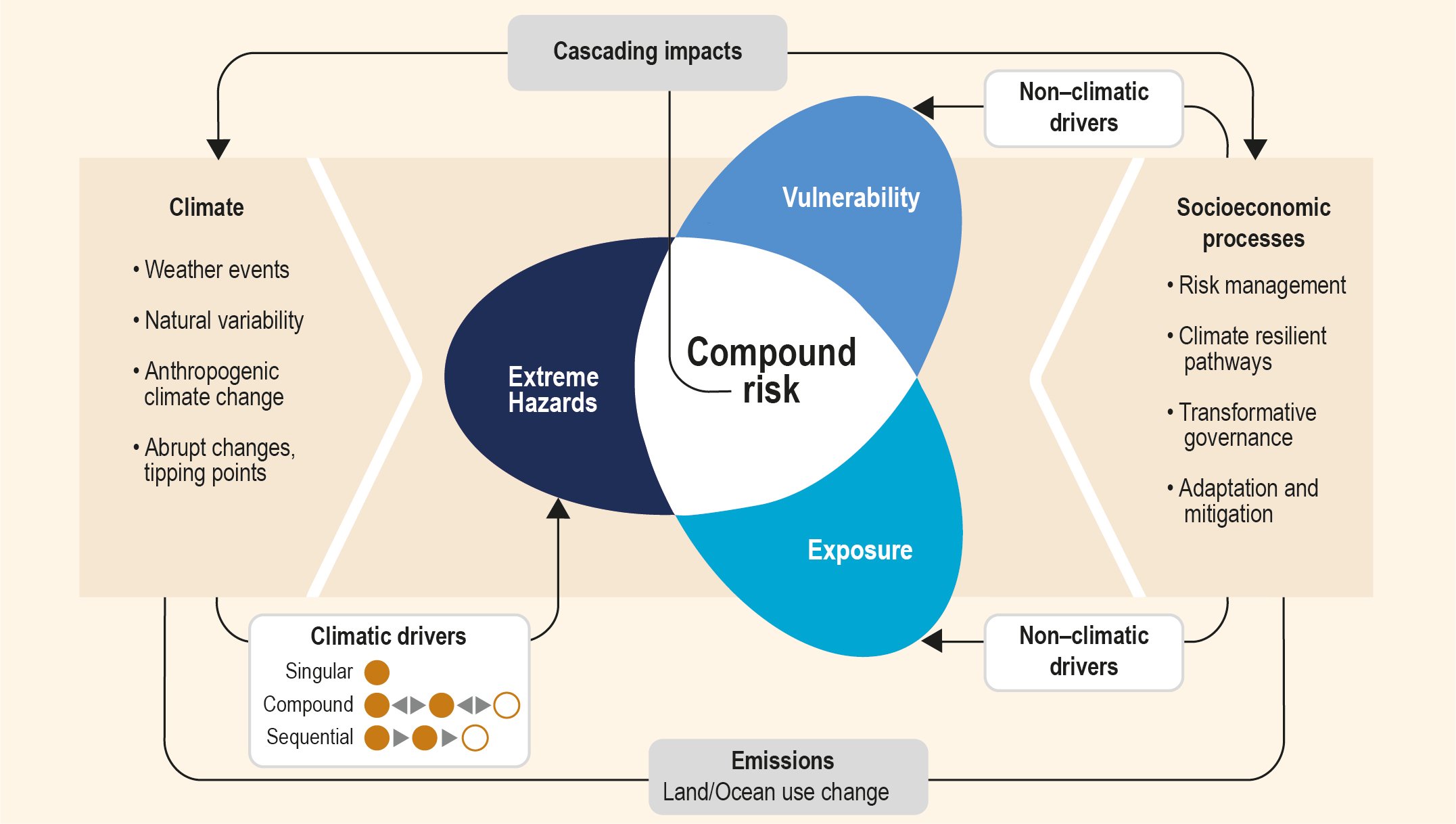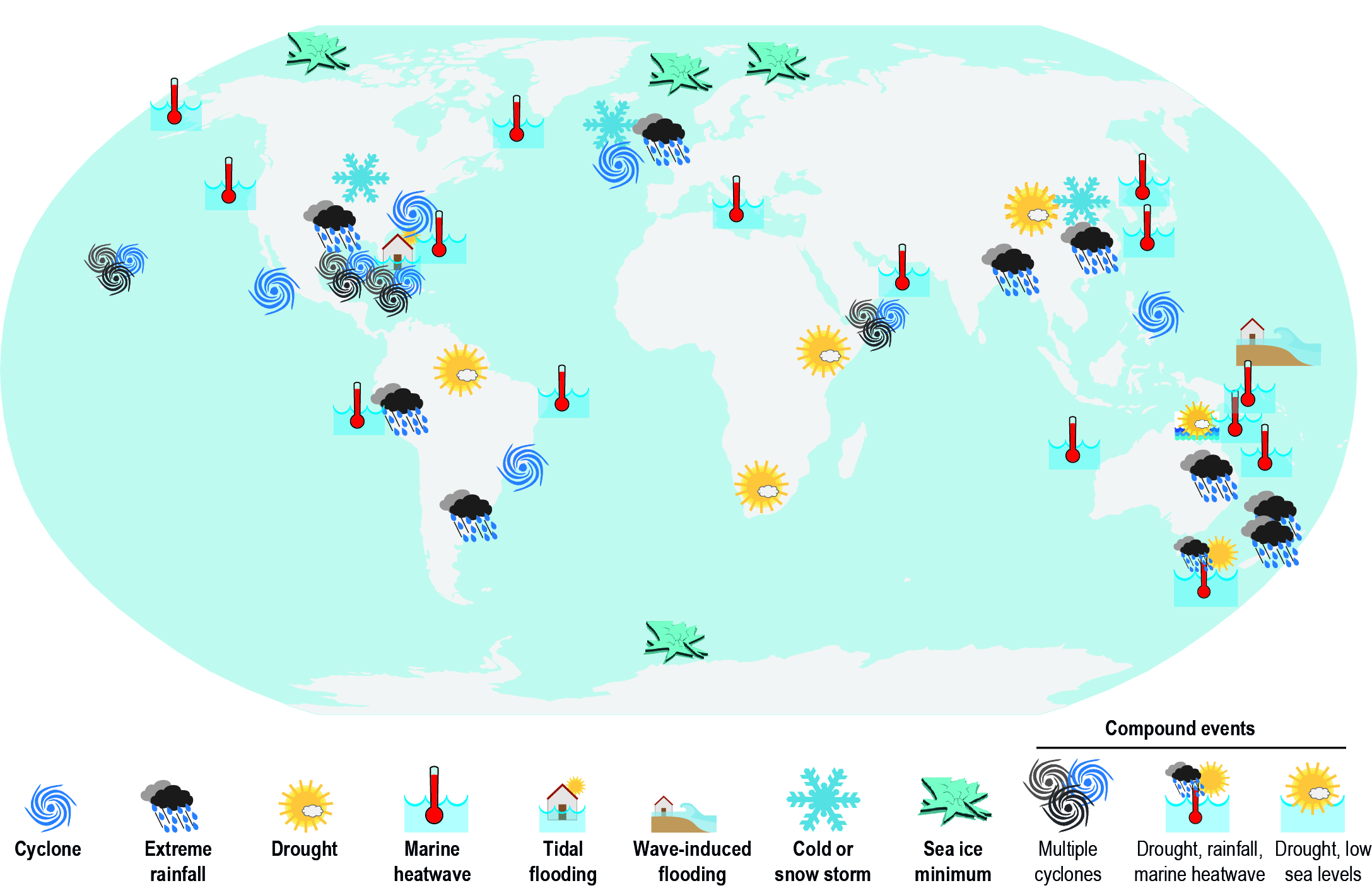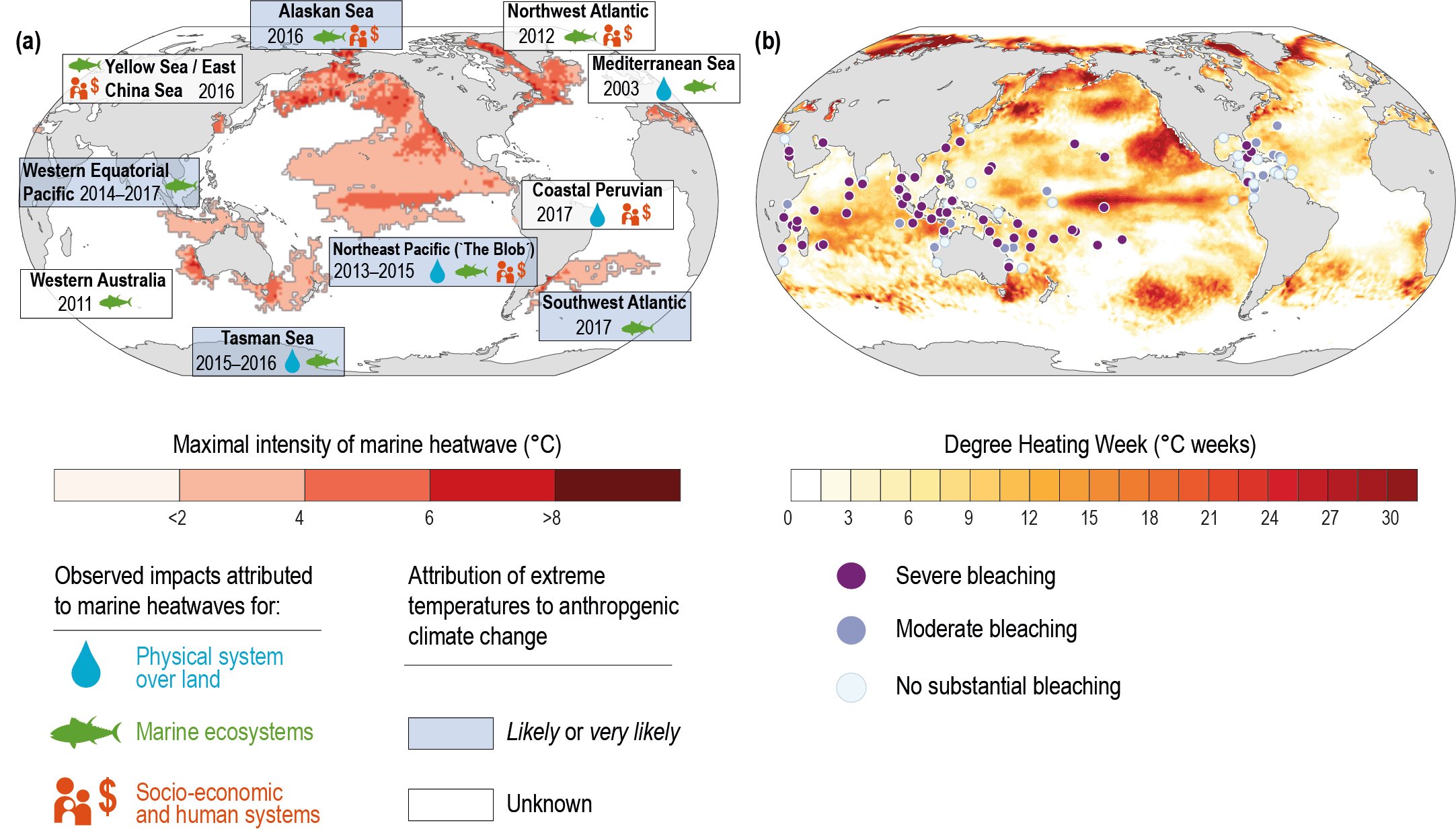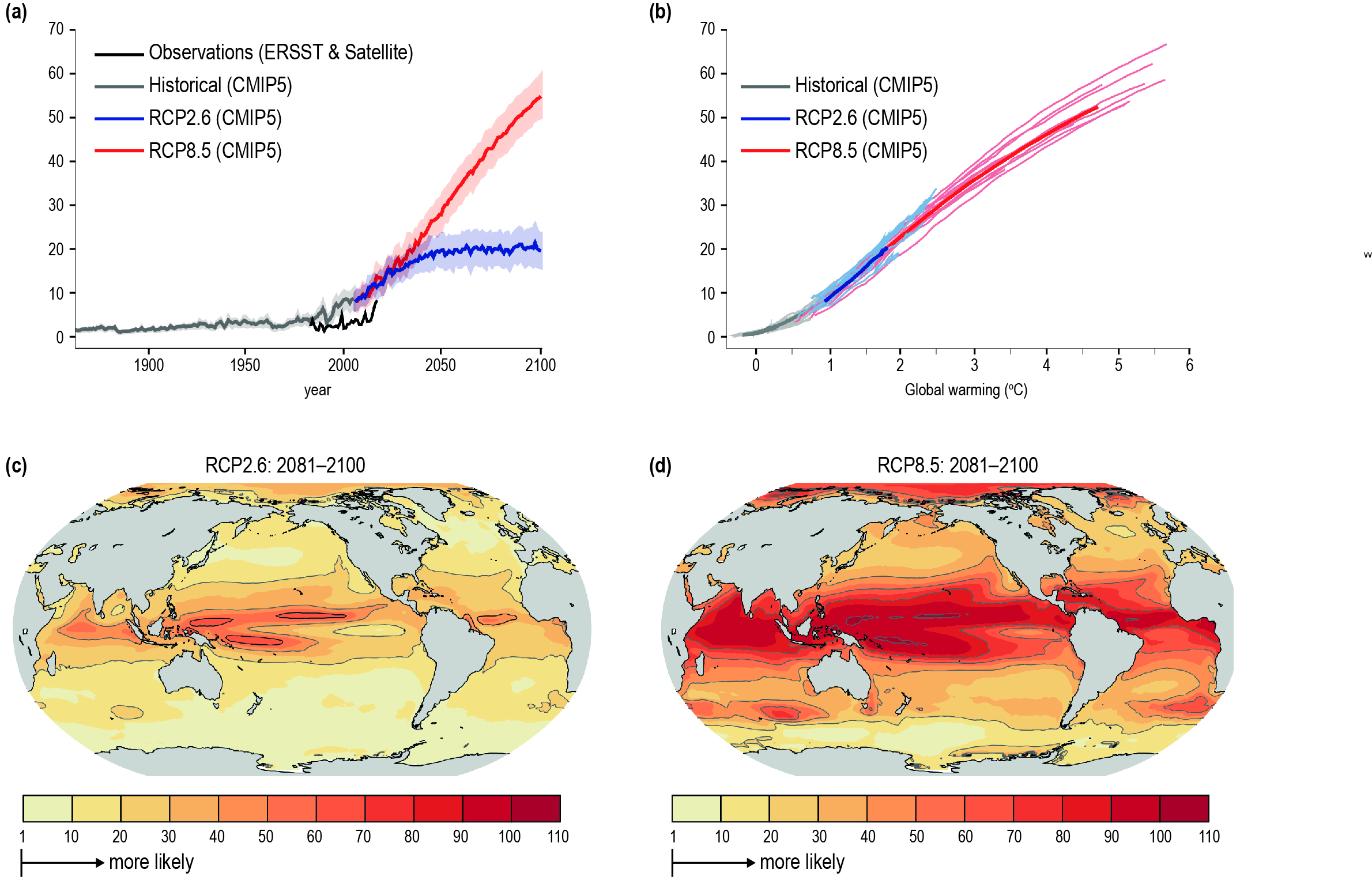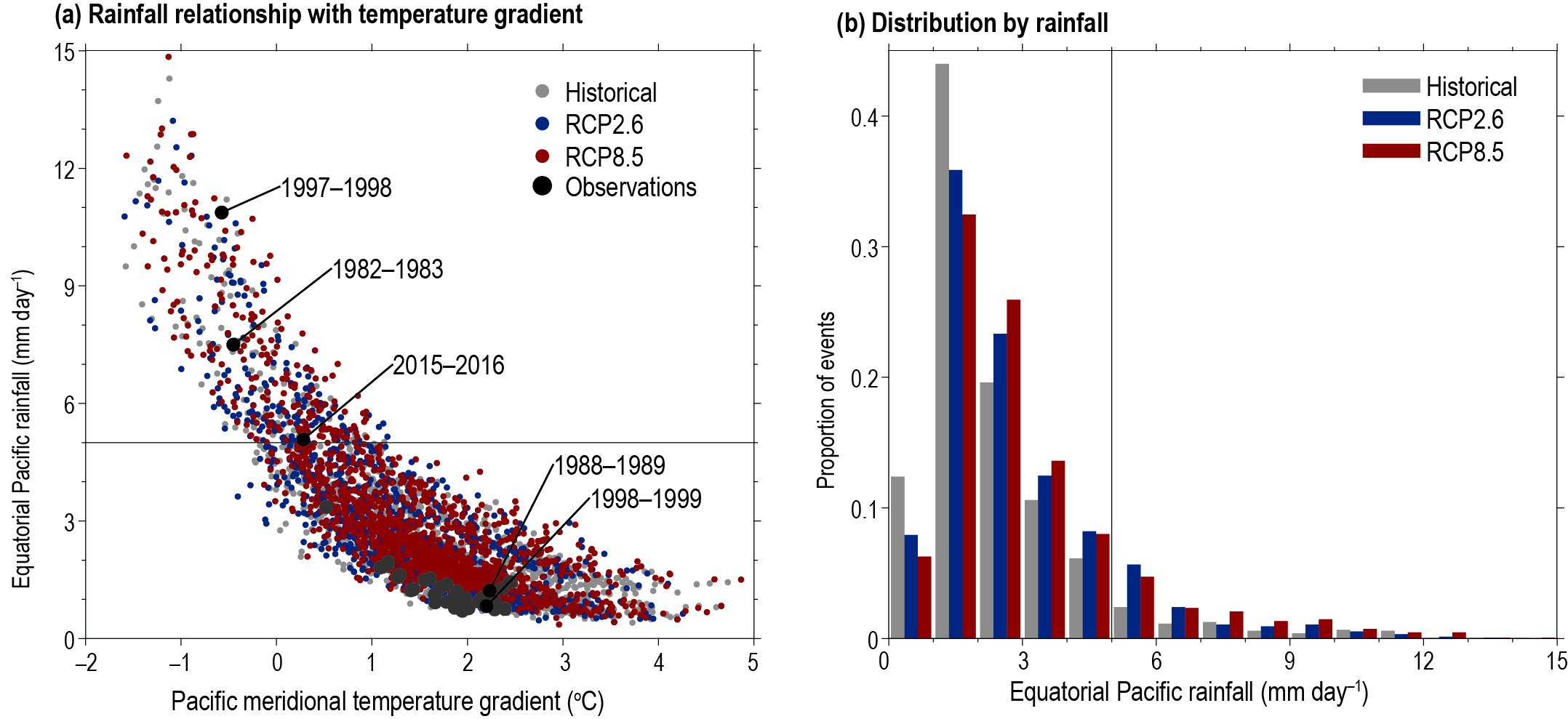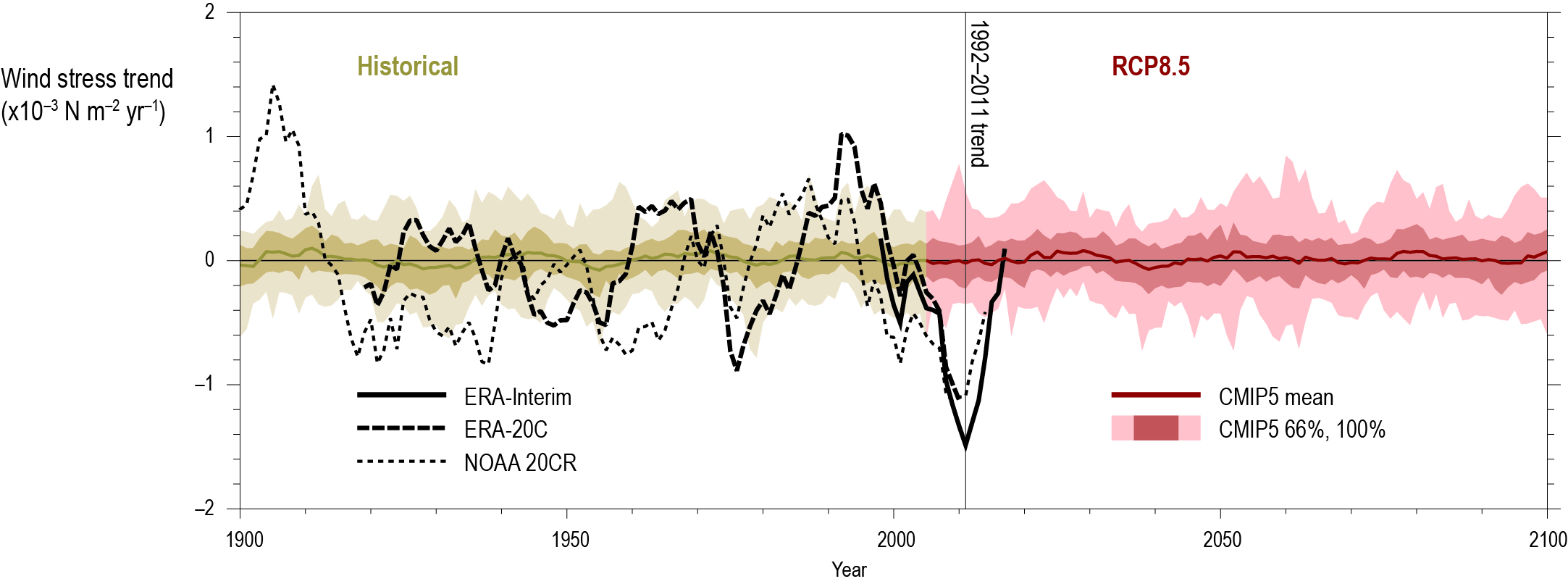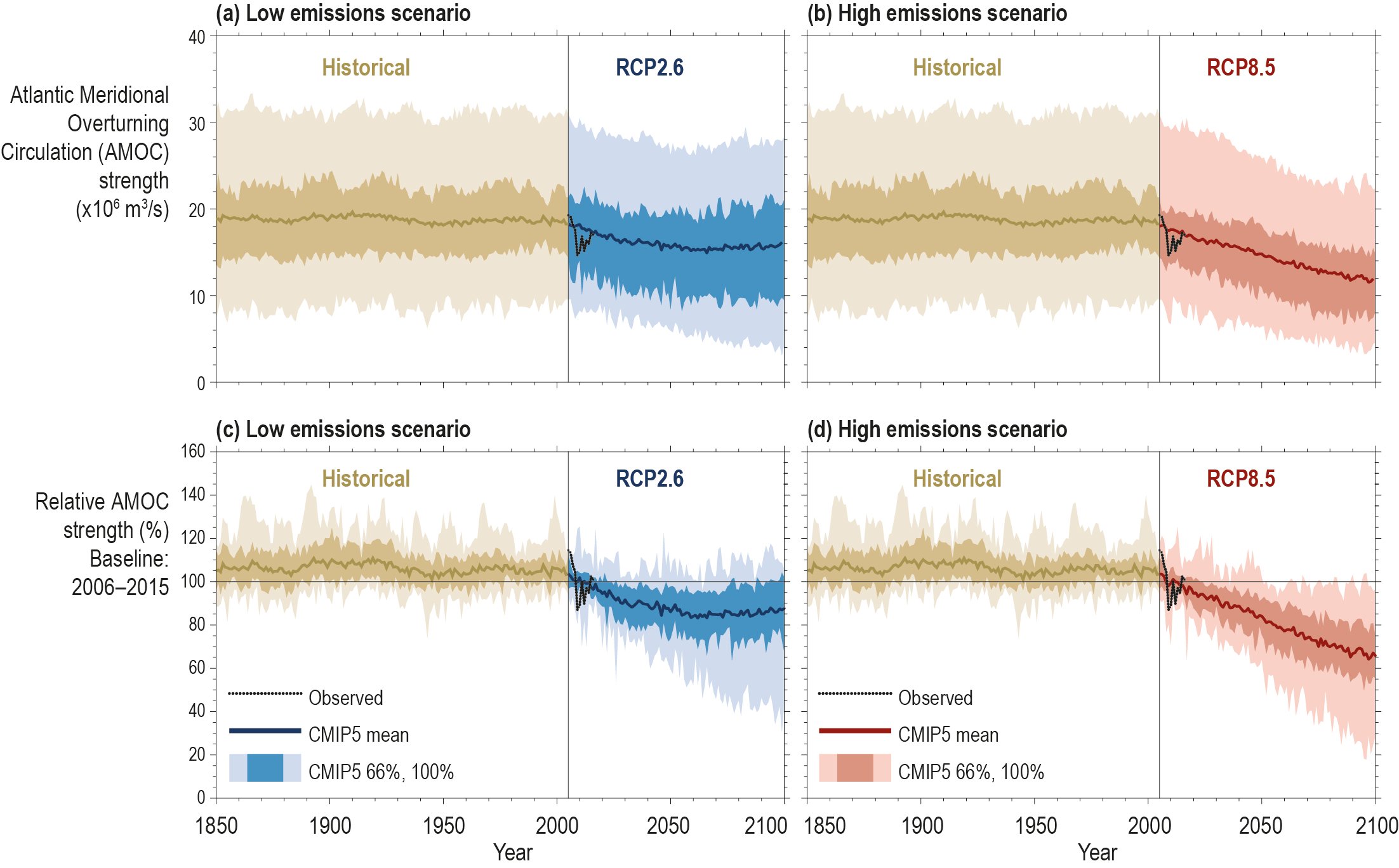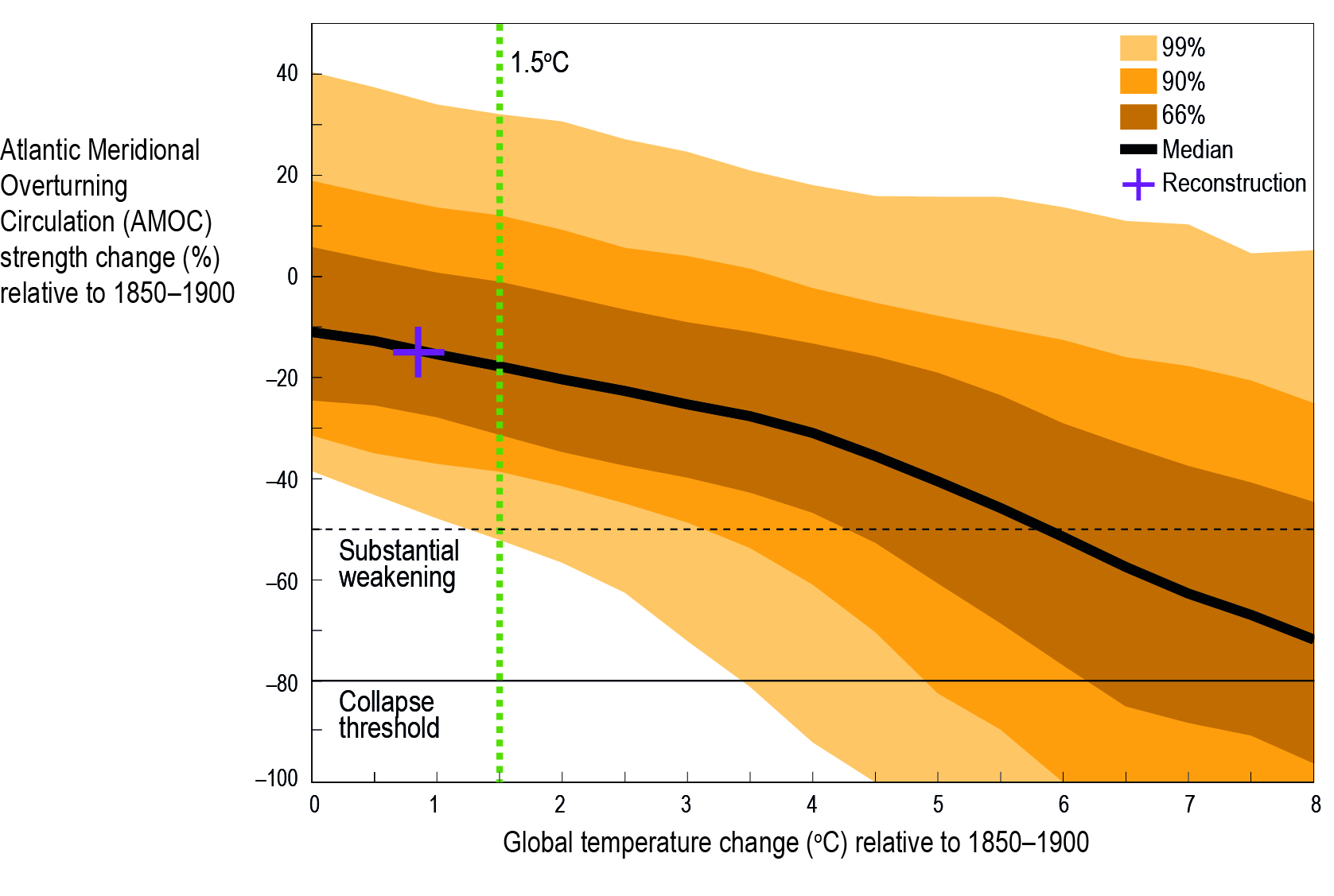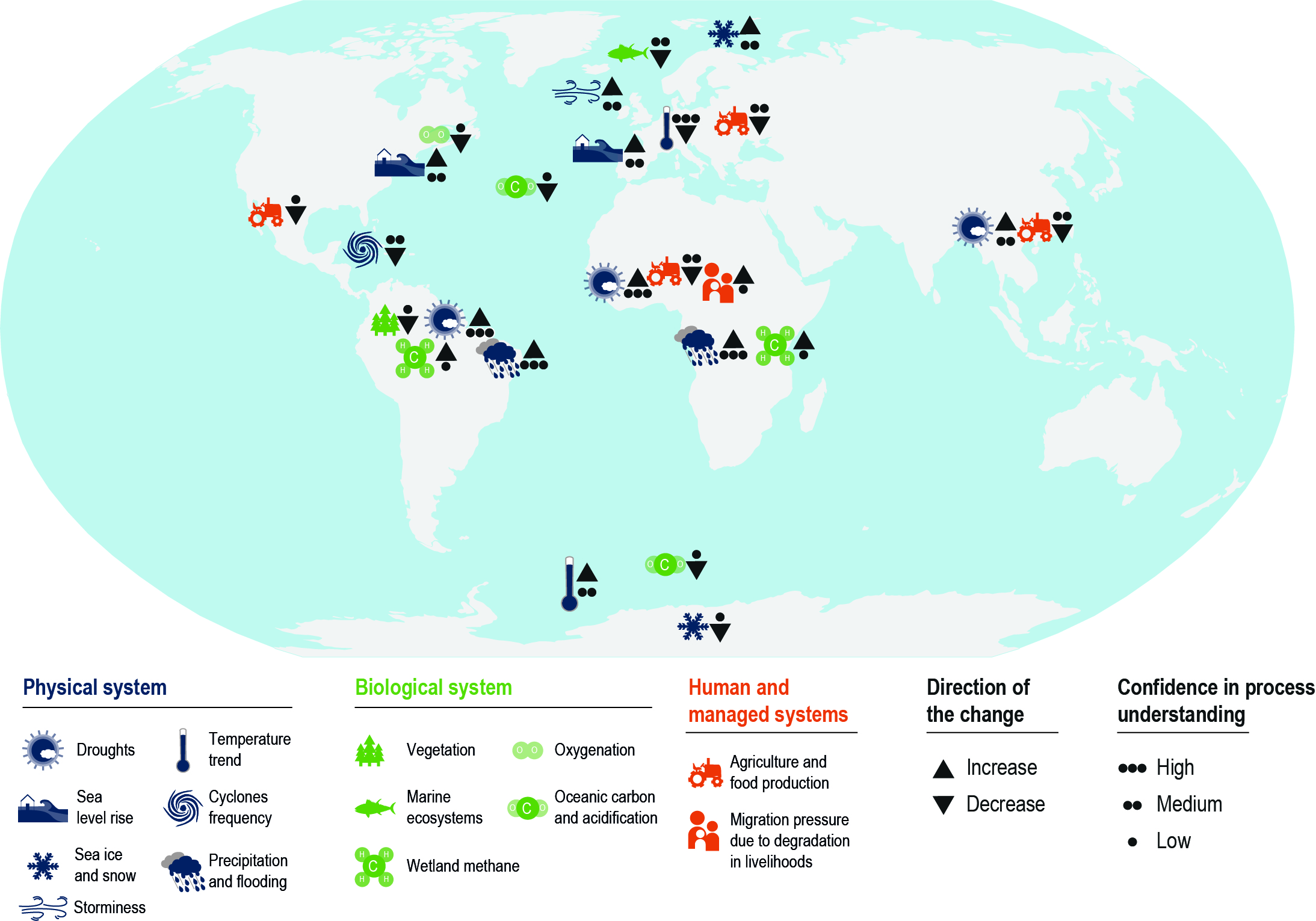ES
Executive Summary
This chapter assesses extremes and abrupt or irreversible changes in the ocean and cryosphere in a changing climate, to identify regional hot spots, cascading effects, their impacts on human and natural systems, and sustainable and resilient risk management strategies. It is not comprehensive in terms of the systems assessed and some information on extremes, abrupt and irreversible changes, in particular for the cryosphere, may be found in other chapters
Ongoing and Emerging Changes in the Ocean and Cryosphere, and their Impacts on Ecosystems and Human Societies
Anthropogenic climate change has increased observed precipitation (medium confidence), winds (low confidence), and extreme sea level events (high confidence) associated with some tropical cyclones, which has increased intensity of multiple extreme events and associated cascading impacts (high confidence). Anthropogenic climate change may have contributed to a poleward migration of maximum tropical cyclone intensity in the western North Pacific in recent decades related to anthropogenically-forced tropical expansion (low confidence). There is emerging evidence for an increase in annual global proportion of Category 4 or 5 tropical cyclones in recent decades (low confidence). {6.3, Table 6.2, Figure 6.2, Box 6.1}.
Changes in Arctic sea ice have the potential to influence mid-latitude weather (medium confidence), but there is low confidence in the detection of this influence for specific weather types. {6.3}
Extreme wave heights, which contribute to extreme sea level events, coastal erosion and flooding, have increased in the Southern and North Atlantic Oceans by around 1.0 cm yr–1 and 0.8 cm yr–1 over the period 1985–2018 (medium confidence). Sea ice loss in the Arctic has also increased wave heights over the period 1992–2014 (medium confidence). {6.3}
Marine heatwaves (MHWs), periods of extremely high ocean temperatures, have negatively impacted marine organisms and ecosystems in all ocean basins over the last two decades, including critical foundation species such as corals, seagrasses and kelps (very high confidence). Globally, marine heat related events have increased; marine heatwaves, defined when the daily sea surface temperature exceeds the local 99th percentile over the period 1982 to 2016, have doubled in frequency and have become longer-lasting, more intense and more extensive (very likely). It is very likely that between 84–90% of marine heatwaves that occurred between 2006 and 2015 are attributable to the anthropogenic temperature increase.{6.4, Figures 6.3, 6.4}
Both palaeoclimate and modern observations suggest that the strongest El Niño and La Niña events since the pre-industrial have occurred during the last fifty years (medium confidence). There have been three occurrences of extreme El Niño events during the modern observational period (1982–1983, 1997–1998, 2015–2016), all characterised by pronounced rainfall in the normally dry equatorial East Pacific. There have been two occurrences of extreme La Niña (1988–1989, 1998–1999). El Niño and La Niña variability during the last 50 years is unusually high compared with average variability during the last millennium. {6.5, Figure 6.5}
The equatorial Pacific trade wind system experienced an unprecedented intensification during 2001–2014, resulting in enhanced ocean heat transport from the Pacific to the Indian Ocean, influencing the rate of global temperature change (medium confidence). In the last two decades, total water transport from the Pacific to the Indian Ocean by the Indonesian Throughflow (ITF), and the Indian Ocean to Atlantic Ocean has increased (high confidence). Increased ITF has been linked to Pacific cooling trends and basin-wide warming trends in the Indian Ocean. Pacific sea surface temperature (SST) cooling trends and strengthened trade winds have been linked to an anomalously warm tropical Atlantic. {6.6, Figure 6.7}
Observations, both in situ (2004–2017) and based on sea surface temperature reconstructions, indicate that the Atlantic Meridional Overturning Circulation (AMOC) has weakened relative to 1850–1900 (medium confidence). There is insufficient data to quantify the magnitude of the weakening, or to properly attribute it to anthropogenic forcing due to the limited length of the observational record. Although attribution is currently not possible, CMIP5 model simulations of the period 1850–2015, on average, exhibit a weakening AMOC when driven by anthropogenic forcing. {6.7, Figure 6.8}
Climate change is modifying multiple types of climate-related events or hazards in terms of occurrence, intensity and periodicity. It increases the likelihood of compound hazards that comprise simultaneously or sequentially occurring events to cause extreme impacts in natural and human systems. Compound events in turn trigger cascading impacts (high confidence). Three case studies are presented in the chapter, (i) Tasmania’s Summer of 2015–2016, (ii) The Coral Triangle and (ii) Hurricanes of 2017. {6.8, Box 6.1}
Projections of Ocean and Cryosphere Change and Hazards to Ecosystems and Human Society Under Low and High Emission Futures
The average intensity of tropical cyclones, the proportion of Category 4 and 5 tropical cyclones and the associated average precipitation rates are projected to increase for a 2°C global temperature rise above any baseline period (medium confidence). Rising mean sea levels will contribute to higher extreme sea levels associated with tropical cyclones (very high confidence). Coastal hazards will be exacerbated by an increase in the average intensity, magnitude of storm surge and precipitation rates of tropical cyclones. There are greater increases projected under RCP8.5 than under RCP2.6 from around mid-century to 2100 (medium confidence). There is low confidence in changes in the future frequency of tropical cyclones at the global scale. {6.3.1}
Significant wave heights (the average height from trough to crest of the highest one-third of waves) are projected to increase across the Southern Ocean and tropical eastern Pacific (high confidence) and Baltic Sea (medium confidence) and decrease over the North Atlantic and Mediterranean Sea under RCP8.5 (high confidence). Coastal tidal amplitudes and patterns are projected to change due to sea level rise and coastal adaptation measures (very likely). Projected changes in waves arising from changes in weather patterns, and changes in tides due to sea level rise, can locally enhance or ameliorate coastal hazards (medium confidence). {6.3.1, 5.2.2}
Marine heatwaves are projected to further increase in frequency, duration, spatial extent and intensity (maximum temperature) (very high confidence). Climate models project increases in the frequency of marine heatwaves by 2081-2100, relative to 1850–1900, by approximately 50 times under RCP8.5 and 20 times under RCP2.6 (medium confidence). The largest increases in frequency are projected for the Arctic and the tropical oceans (medium confidence). The intensity of marine heatwaves is projected to increase about 10-fold under RCP8.5 by 2081–2100, relative to 1850–1900 (medium confidence). {6.4}
Extreme El Niño and La Niña events are projected to likely increase in frequency in the 21st century and to likely intensify existing hazards, with drier or wetter responses in several regions across the globe. Extreme El Niño events are projected to occur about as twice as often under both RCP2.6 and RCP8.5 in the 21st century when compared to the 20th century (medium confidence). Projections indicate that extreme Indian Ocean Dipole events also increase in frequency (low confidence). {6.5; Figures 6.5, 6.6}
Lack of long-term sustained Indian and Pacific Ocean observations, and inadequacies in the ability of climate models to simulate the magnitude of trade wind decadal variability and the inter-ocean link, mean there is low confidence in future projections of the trade wind system. {6.6, Figure 6.7}
The AMOC will very likely weaken over the 21st century (high confidence), although a collapse is very unlikely (medium confidence). Nevertheless, a substantial weakening of the AMOC remains a physically plausible scenario. Such a weakening would strongly impact natural and human systems, leading to a decrease in marine productivity in the North Atlantic, more winter storms in Europe, a reduction in Sahelian and South Asian summer rainfall, a decrease in the number of TCs in the Atlantic, and an increase in regional sea level around the Atlantic especially along the northeast coast of North America (medium confidence). Such impacts would be superimposed on the global warming signal. {6.7, Figure 6.8}
Impacts from further changes in TC and ETCs, MHWs, extreme El Niño and La Niña events and other extremes will exceed the limits of resilience and adaptation of ecosystems and people, leading to unavoidable loss and damage (medium confidence). {6.9.2}
Strengthening the Global Responses in the Context of Sustainable Development Goals (SDGs) and Charting Climate Resilient Development Pathways for Oceans and Cryosphere
There is medium confidence that including extremes and abrupt changes, such as AMOC weakening, ice sheet collapse (West Antarctic Ice Sheet (WAIS) and Greenland Ice Sheet (GIS)), leads to a several-fold increase in the cost of carbon emissions (medium confidence). If carbon emissions decline, the risk of extremes and abrupt changes are reduced, creating co-benefits. {6.8.5}
For TCs and ETCs, investment in disaster risk reduction, flood management (ecosystem and engineered) and early warning systems decreases economic loss (medium confidence), but such investments may be hindered by limited local capacities, such as increased losses and mortality from extreme winds and storm surges in less developed countries despite adaptation efforts. There is emerging evidence of increasing risks for locations impacted by unprecedented storm trajectories (low confidence). Managing the risk from such changing storm trajectories and intensity proves challenging because of the difficulties of early warning and its receptivity by the affected population (high confidence). {6.3, 6.9}
Limiting global warming would reduce the risk of impacts of MHWs, but critical thresholds for some ecosystems (e.g., kelp forests, coral reefs) will be reached at relatively low levels of future global warming (high confidence). Early warning systems, producing skillful forecasts of MHWs, can further help to reduce the vulnerability in the areas of fisheries, tourism and conservation, but are yet unproven at large scale (medium confidence). {6.4}
Sustained long-term monitoring and improved forecasts can be used in managing the risks of extreme El Niño and La Niña events associated with human health, agriculture, fisheries, coral reefs, aquaculture, wildfire, drought and flood management (high confidence). {6.5}
Extreme change in the trade wind system and its impacts on global variability, biogeochemistry, ecosystems and society have not been adequately understood and represent significant knowledge gaps. {6.6}
By 2300, an AMOC collapse is as likely as not for high emission pathways and very unlikely for lower ones, highlighting that an AMOC collapse can be avoided in the long term by CO2 mitigation (medium confidence). Nevertheless, the human impact of these physical changes have not been sufficiently quantified and there are considerable knowledge gaps in adaptation responses to a substantial AMOC weakening. {6.7}
The ratio between risk reduction investment and reduction of damages of extreme events varies. Investing in preparation and prevention against the impacts from extreme events is very likely less than the cost of impacts and recovery (medium confidence). Coupling insurance mechanisms with risk reduction measures can enhance the cost-effectiveness of adapting to climate change (medium confidence). {6.9}
Climate change adaptation and disaster risk reduction require capacity building and an integrated approach to ensure trade-offs between short- and long-term gains in dealing with the uncertainty of increasing extreme events, abrupt changes and cascading impacts at different geographic scales (high confidence). {6.9}
Limiting the risk from the impact of extreme events and abrupt changes leads to successful adaptation to climate change with the presence of well-coordinated climate-affected sectors and disaster management relevant agencies (high confidence). Transformative governance inclusive of successful integration of disaster risk management (DRM) and climate change adaptation, empowerment of vulnerable groups, and accountability of governmental decisions promotes climate-resilient development pathways (high confidence). {6.9}
